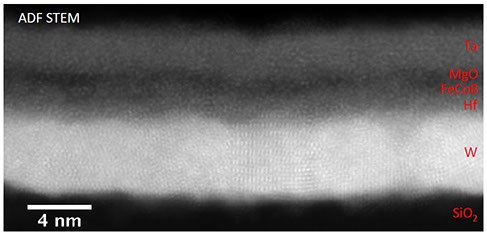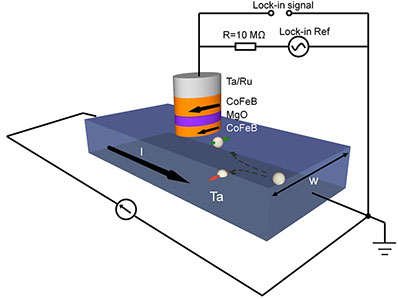Research Topics
Magnetic heterostructure growth and characterization
Thin-film ferromagnetic materials deposited in adjacent to other transition metals and/or oxide layers can induce interfacial magnetic anisotropy. For instance, as shown in this dark-field STEM image, the ~1nm FeCoB alloy that is sandwiched between a Hf buffer layer and a MgO capping layer demonstrates perpendicular magnetic anisotropy (PMA). This PMA can be further tuned by post-annealing process, applied strain/stress, as well as applied voltage across the heterostructure.

Image courtesy of David A. Muller group at Cornell University
Spin Hall effect induced spin transfer torque and its applications
The spin Hall effect (SHE) in heavy transition metals has been experimentally proved to be strong enough to induce magnetization switching and magnetic oscillations in the adjacent ferromagnetic layer via spin transfer torque (STT) mechanism. The spin Hall angle, which roughly describes the sign and the magnitude of the charge-to-spin conversion efficiency, is about 0.06, -0.15, and -0.30 for Pt, Ta, and W, respectively.
Other novel materials systems such as topological insulators have also been proved to possess giant spin Hall effect, with spin Hall angle possibly greater than unity (>100%). Our research aims for materials systems with high spin Hall efficiency and their potential applications, for instance in the magnetic random access memory (MRAM) industry.

Illustration of a 3-terminal device utilizing the SHE-STT
Chiral domain wall motion and dynamics of exotic spin textures
The domain wall in magnetic nanowires can serve as an information carrier between magnetic memory elements. The efficiency of the domain wall propagation, however, is strongly related to the type of the ferromagnetic material, the magnetic anisotropy therein, and the strength of the spin transfer torque stemming from the magnetic heterostructure. The dynamics of domain walls and other spin textures (for instance, like skyrmions) in magnetic heterostructures with perpendicular magnetic anisotropy (PMA) has been shown to be controlled by the spin Hall effect (SHE) from the bulk and the Dzyaloshinskii-Moriya Interaction (DMI) at the transition metal-ferromagnetic material interface. We are interested in both the physics and the applications of these dynamical properties of spin textures.


Magneto-optical Kerr microscopy (MOKE) videos of different magnetic domain expansion modes
© 2016 Pai Research Lab